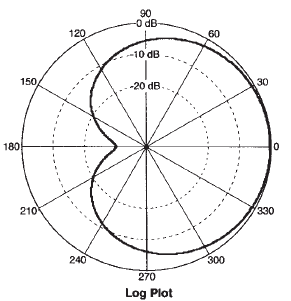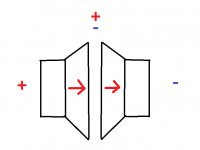Why's it a cardioid? Because of what's (not) going on in the gap?So now we have a cardioid plus a built-in trap. Is that correct?
< ++++> ====< null >====<----->
So now we have a cardioid plus a built-in trap. Is that correct?
This is not a cardioid pattern.
A cardiod has a null to the rear, and non-zero radiation at +/-90degrees, like this:

That's an interesting setup, but I do not see any real advantages over a single woofer... at all. All this does is position the acoustic centers of the front and rear radiation farther apart, which just makes the dipole fall apart at a lower frequency. This is not an "advantage" AFAIK.
Also, the tweeter pair is too far apart to make a good dipole, as evidenced by all the crossing on and off axis responses above 2kHz. The lines should follow each other, tracking together, as much as possible. Instead it's a bit of a mess. If you measured with higher resolution you would see this more clearly. This is exactly what others have reported when trying to use two tweeters back-to-back as a dipole. Because of the magnet structure it is impossible to get the two acoustic centers close enough to create a dipole at high frequencies, where you want to use them.
But hanging the drivers by wire or string IS a good way to isolate the drivers from other drivers in the system. Good job there. I would not hang the tweeter from the woofers, however. All drivers need to hang separately. I use this approach in a "nude OB" system I built recently, and it works well. I used monofilament nylon (like very heavy duty fishing line) which is unobtrusive.
If space is not a problem then yeah. It has the output capability of an 8" woofer though while being smaller in size. The symmetry is also nice when suspending as I won't have to fiddle with most of the weight being off center. It is also symmetric front back up to 2 khz where an 8" would start to fall off at the rear at 1 khz. It probably isn't as smooth though so there is that.
I'm not sure this is the tweeter combo to rule them all either, but I had them so I might as well try.
And yeah, in that combo there is too much vibration transferred to the tweeters for my liking. The next idea is that if I cross above 1 khz the upper mid / tweeter will have little enough viration such that I can mount them straight on the arm without worrying about rattling, and then suspend the midwoofers below as in this setup.
Please clarify some points about your woofer setup...
Unless I am mistaken about how you are driving these two, it has the same output as a single driver. You said in post #3 that they are "out of phase electrically" yet they face each other so physically this reverses the "phase" of one of them with respect to the other. This means the pair is operating "in phase" that is the both cones move either forward or rearward together. Is that right? You can check this with a very low frequency signal (like 2 Hz), or by connecting a 9V battery in place of the amp and inspecting how the cones move.
If instead the cones are moving in opposite directions, e.g. first towards each other and then away from each other, then you have two closely spaced dipoles that are out of phase. Not sure what that is... (GedLee mentioned "quadra pole") but since your off-axis measurements look more like a dipole I am guessing this is not how you have it set up.
I can't quite make out the Satori model number on the magnet, but judging by the waveguide you have a pair of 6" woofers, maybe MW16P? You say this arrangement has the "output capability of an 8" woofer". I think you might be thinking that the output is adding like two monopoles, e.g. when you use two woofers in a sealed box. With dipoles or combinations of dipoles the output does not add like that.
Unless I am mistaken about how you are driving these two, it has the same output as a single driver. You said in post #3 that they are "out of phase electrically" yet they face each other so physically this reverses the "phase" of one of them with respect to the other. This means the pair is operating "in phase" that is the both cones move either forward or rearward together. Is that right? You can check this with a very low frequency signal (like 2 Hz), or by connecting a 9V battery in place of the amp and inspecting how the cones move.
If instead the cones are moving in opposite directions, e.g. first towards each other and then away from each other, then you have two closely spaced dipoles that are out of phase. Not sure what that is... (GedLee mentioned "quadra pole") but since your off-axis measurements look more like a dipole I am guessing this is not how you have it set up.
If space is not a problem then yeah. It has the output capability of an 8" woofer though while being smaller in size. The symmetry is also nice when suspending as I won't have to fiddle with most of the weight being off center. It is also symmetric front back up to 2 khz where an 8" would start to fall off at the rear at 1 khz. It probably isn't as smooth though so there is that.
I can't quite make out the Satori model number on the magnet, but judging by the waveguide you have a pair of 6" woofers, maybe MW16P? You say this arrangement has the "output capability of an 8" woofer". I think you might be thinking that the output is adding like two monopoles, e.g. when you use two woofers in a sealed box. With dipoles or combinations of dipoles the output does not add like that.
Please clarify some points about your woofer setup...
Unless I am mistaken about how you are driving these two, it has the same output as a single driver. You said in post #3 that they are "out of phase electrically" yet they face each other so physically this reverses the "phase" of one of them with respect to the other. This means the pair is operating "in phase" that is the both cones move either forward or rearward together. Is that right? You can check this with a very low frequency signal (like 2 Hz), or by connecting a 9V battery in place of the amp and inspecting how the cones move.
If instead the cones are moving in opposite directions, e.g. first towards each other and then away from each other, then you have two closely spaced dipoles that are out of phase. Not sure what that is... (GedLee mentioned "quadra pole") but since your off-axis measurements look more like a dipole I am guessing this is not how you have it set up.
I can't quite make out the Satori model number on the magnet, but judging by the waveguide you have a pair of 6" woofers, maybe MW16P? You say this arrangement has the "output capability of an 8" woofer". I think you might be thinking that the output is adding like two monopoles, e.g. when you use two woofers in a sealed box. With dipoles or combinations of dipoles the output does not add like that.
They are moving out of phase thus as a dipole. If I seal the cavity then I agree, Linkwitz calls them compound dipoles and predicts that they should sum as two dipoles with a distance D like if I would place them on top of another in a normal setup. My measurements support this as I have just 3 dB dipole loss due to smaller baffle when comparing the U-frame and the bigger and the conventionally baffled dipole, blue is conventional and red is the compound.
If I wire them in phase then I don't get any bass output at all as they eliminate everything less than 1 khz very efficiently =) See second measurement here.
And yes, that is the MW16P
Attachments
Last edited:
They are moving out of phase thus as a dipole. If I seal the cavity then I agree, Linkwitz calls them compound dipoles and predicts that they should sum as two dipoles with a distance D like if I would place them on top of another in a normal setup. My measurements support this as I have just 3 dB dipole loss due to smaller baffle when comparing the U-frame and the bigger and the conventionally baffled dipole, blue is conventional and red is the compound.
If I wire them in phase then I don't get any bass output at all as they eliminate everything less than 1 khz very efficiently =) See second measurement here.
And yes, that is the MW16P
I think it's not really going to function as a compound dipole because the drivers are so close together, but maybe... The SL illustration is found here:
Electro-acoustic models
What you have is essentially just a bad dipole. I say "bad", because it is worse than one driver alone, but has no benefits over a single driver. That is in general how I think about higher order gradients, too...
All this arrangement really does is move the distance between the "front" and "rear" sources a bit farther apart compared to a single driver. This makes the dipole pattern break down at a lower frequency. It's the exact same thing that is plaguing your tweeter pair. Also, the magnet is right in front of both drivers, and that will cause some minor irregularities (or even some major ones if the magnet is larger than with these drivers).
Last edited:
Is there any tool that can model such space separated dipoles?
There should be, in a little while. See
http://www.diyaudio.com/forums/software-tools/317811-xsim-3d-development-math-help.html#post5317462
(so far, I haven't put in a way to put drivers in front of each other, but it wouldn't be too hard to do I don't think)
I have experimented with two woofers both open baffle one after another, in dipole and bipole arrangement, quite a while ago...I liked dipole better. You may find this interesting. Still use it today. Not my invention, others used it before. (Legacy audio for instance)
Audio Pages: Dipole subwoofers
Interesting stuff Adason, have you ever attempted to seal the dipole even a little?
- Status
- This old topic is closed. If you want to reopen this topic, contact a moderator using the "Report Post" button.
- Home
- Loudspeakers
- Multi-Way
- Crazy front to front mounted dipole that measures far better than I expected
